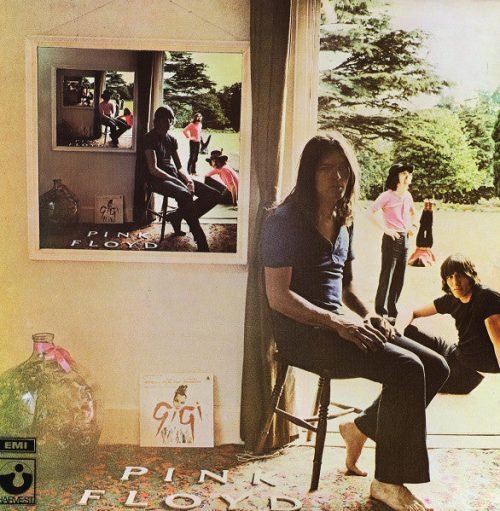Released in 1969, Ummagumma by Pink Floyd stands as a pivotal moment in the band’s illustrious discography and in the broader tapestry of rock music. Situated between the formative psychedelic soundscapes of A Saucerful of Secrets (1968) and the polished conceptual brilliance of Atom Heart Mother (1970), Ummagumma represents both an experimental outlier and a bridge in Pink Floyd’s evolution. This double album is a testament to the band’s willingness to push boundaries, embracing avant-garde experimentation while refining their signature sound.
The late 1960s was a time of rapid innovation and transformation in the music world, with artists exploring new realms of sound and expression. Amidst this cultural ferment, Ummagumma stands out for its daring structure and conceptual audacity. The album is divided into two distinct parts: the first disc captures the raw energy of Pink Floyd’s live performances, while the second disc features solo studio experiments by each band member. This duality not only showcases their individual talents but also highlights the band’s collective versatility.
Artistic Intentions
In creating Ummagumma, Pink Floyd aimed to push the limits of what a rock album could be. The live recordings on the first disc—featuring staples like “Astronomy Domine” and “Careful with That Axe, Eugene”—are infused with a visceral intensity, capturing the band’s dynamic stage presence. Conversely, the studio disc allowed Roger Waters, David Gilmour, Richard Wright, and Nick Mason to delve into personal explorations, each crafting a unique suite that reflects their artistic vision and influences.
The album’s title, derived from Cambridge slang for sex, hints at a playful irreverence and a break from conventional norms. This spirit of experimentation is evident in the album’s eclectic soundscapes, which range from the haunting minimalism of Wright’s “Sysyphus” to the pastoral charm of Gilmour’s “The Narrow Way.” Through Ummagumma, Pink Floyd not only charted new artistic territory but also laid the groundwork for their future masterpieces, showcasing a bold creative ambition that would define their legacy.
Sonic Exploration

Production Quality
Ummagumma stands out in Pink Floyd’s catalog not just for its content but for its production approach, which is split between raw live recordings and intricate studio work. The live disc captures the essence of Pink Floyd’s stage performances with an unpolished, gritty sound that emphasizes the raw energy and spontaneity of their concerts. This lo-fi approach enhances the immersive, almost hypnotic quality of tracks like “Careful with That Axe, Eugene” and “Set the Controls for the Heart of the Sun,” allowing listeners to experience the intensity and atmospheric depth of a live Floyd performance.
Conversely, the studio disc is a testament to meticulous production, showcasing the band’s willingness to experiment with recording techniques and sonic textures. Each band member’s solo contributions are marked by their distinct production choices, ranging from the stark minimalism in Richard Wright’s “Sysyphus” to the layered complexity in David Gilmour’s “The Narrow Way.” This contrast between the live and studio discs not only highlights the band’s versatility but also serves the album’s broader themes of exploration and individuality.
Musical Arrangements
The arrangements on Ummagumma are a rich tapestry of innovative and memorable moments. The live disc maintains a powerful synergy between instruments, creating an expansive, almost orchestral sound with minimal overdubbing. Roger Waters’ bass lines and Nick Mason’s drumming form a robust rhythmic foundation, while Gilmour’s guitar work and Wright’s keyboards weave intricate melodies and atmospheric effects. This is particularly evident in the 12-minute epic “A Saucerful of Secrets,” where each instrument contributes to a crescendo of sonic intensity.
The studio disc, on the other hand, offers a diverse array of arrangements that reflect each member’s unique artistic vision. Wright’s “Sysyphus” suite is an avant-garde exploration of classical motifs and dissonant soundscapes, featuring complex piano arrangements and eerie synthesizer effects. Gilmour’s “The Narrow Way” blends acoustic and electric guitars in a multi-part composition that transitions from pastoral beauty to psychedelic rock.
Roger Waters’ “Several Species of Small Furry Animals Gathered Together in a Cave and Grooving with a Pict” is an experimental piece that uses tape loops and vocal manipulations to create an almost surreal auditory experience. Finally, Nick Mason’s “The Grand Vizier’s Garden Party” incorporates percussion and flute in a three-part suite that oscillates between structured composition and freeform improvisation.
Genre Elements
Ummagumma defies easy categorization, blending a variety of genres and subgenres in a novel way. The live disc retains elements of psychedelic rock, with its extended improvisations and experimental soundscapes. This is complemented by touches of space rock, especially in tracks like “Astronomy Domine,” which features cosmic themes and otherworldly sonic effects.
The studio disc, however, ventures into more avant-garde and experimental territory. Wright’s and Mason’s contributions flirt with classical and modernist influences, while Gilmour’s “The Narrow Way” incorporates folk and blues elements into its progressive rock framework. Waters’ piece, with its innovative use of tape loops and found sounds, hints at early musique concrète and sound collage techniques.
Lyrical Analysis

Themes and Messages
Unlike many of Pink Floyd’s later works, Ummagumma is not driven primarily by its lyrics. The album’s central themes are conveyed more through its sonic experimentation and instrumental prowess than through traditional storytelling or lyrical content. However, when lyrics are present, they delve into abstract and sometimes surreal territory. On the live disc, “Astronomy Domine” revisits the band’s fascination with space and the cosmos, a recurring motif in their earlier work, capturing a sense of wonder and exploration.
In the studio disc, the lyrical content is sparse and often secondary to the musical experimentation. Roger Waters’ contributions, such as “Grantchester Meadows,” offer a pastoral, almost nostalgic glimpse into tranquil English countryside life, contrasting sharply with his later, more politically charged writing. The lyrics in “The Narrow Way” by David Gilmour touch upon themes of isolation and introspection, reflecting a more personal and introspective perspective.
Lyrical Depth
The lyrics on Ummagumma are characterized by their abstract, impressionistic quality. They are often open to interpretation, inviting listeners to find their own meanings rather than presenting straightforward narratives. This is particularly evident in Waters’ “Several Species of Small Furry Animals Gathered Together in a Cave and Grooving with a Pict,” where the “lyrics” are actually a series of manipulated vocal sounds that create an atmosphere rather than conveying a clear message.
“Grantchester Meadows” is one of the more lyrically accessible tracks, painting a vivid picture of rural tranquility with lines like “Hear the lark and harken to the barking of the dog fox gone to ground.” The simplicity and poetic nature of the lyrics evoke a serene and bucolic scene, showcasing Waters’ ability to craft evocative imagery.
Emotional Impact
The emotional resonance of Ummagumma is multifaceted, with the lyrics contributing to a broader emotional palette shaped by the album’s musical diversity. In the live performances, the lyrics—while minimal—combine with the music to create an intense, almost transcendental experience. “Careful with That Axe, Eugene,” for example, features sparse lyrics that heighten the track’s menacing and suspenseful mood, culminating in a cathartic scream that leaves a lasting impact.
On the studio disc, the emotional range is more varied. “Grantchester Meadows” induces a sense of calm and nostalgia, while the enigmatic sounds of “Several Species of Small Furry Animals Gathered Together in a Cave and Grooving with a Pict” evoke curiosity and amusement. Gilmour’s “The Narrow Way” progresses from an introspective acoustic piece to a powerful, layered rock arrangement, reflecting a journey from solitude to a more assertive self-awareness.
Cohesion and Flow

Track Progression
Ummagumma presents an intriguing and unconventional structure that challenges traditional notions of album cohesion and flow. The album is distinctly divided into two parts: the first disc, which captures the raw energy of Pink Floyd’s live performances, and the second disc, which features individual studio compositions by each band member. This bifurcation creates a unique listening experience where the flow is less about seamless transitions between tracks and more about contrasting the different facets of the band’s artistry.
On the live disc, the tracks flow with a natural intensity, capturing the atmosphere of a Pink Floyd concert. The transition from the frenetic “Astronomy Domine” to the haunting “Careful with That Axe, Eugene” is particularly effective, maintaining an emotional and sonic intensity that draws the listener in. “Set the Controls for the Heart of the Sun” continues this momentum with its hypnotic rhythms, leading seamlessly into the sprawling “A Saucerful of Secrets,” which concludes the live experience on an expansive, epic note.
The studio disc, however, presents a more fragmented flow. Each band member’s solo contribution is a distinct, self-contained piece, leading to a variety of styles and moods. The transition from Wright’s classical and avant-garde “Sysyphus” to Waters’ pastoral “Grantchester Meadows” and then to Gilmour’s multi-part “The Narrow Way” can feel jarring. Mason’s “The Grand Vizier’s Garden Party” closes the studio disc with a blend of structured composition and freeform experimentation. While the solo tracks offer a fascinating glimpse into each member’s creative vision, the lack of direct continuity between them can disrupt the album’s overall flow.
Thematic Consistency
The thematic consistency of Ummagumma is maintained more through its spirit of experimentation and exploration than through a unified narrative or musical style. The live disc is thematically cohesive, with each track building on the band’s early psychedelic and space rock foundations. The live recordings capture a raw and immersive energy that is thematically consistent, reflecting the band’s live performance prowess and their ability to create expansive sonic landscapes.
The studio disc, however, is thematically diverse, reflecting the individual artistic identities of Waters, Gilmour, Wright, and Mason. While this diversity showcases the breadth of the band’s creativity, it also results in a less cohesive thematic experience. Wright’s “Sysyphus” delves into dark, experimental territory, while Waters’ “Grantchester Meadows” offers a serene, pastoral contrast. Gilmour’s “The Narrow Way” transitions from introspective acoustic to robust rock, and Mason’s “The Grand Vizier’s Garden Party” blends structured percussion with freeform experimentation. These shifts in theme and style can feel disjointed, but they also highlight the band’s willingness to push boundaries and explore new artistic directions.
Despite these thematic and stylistic shifts, Ummagumma remains a cohesive work in the sense that it encapsulates a period of intense creativity and experimentation for Pink Floyd. The album reflects their desire to break free from conventional rock structures and to explore the outer reaches of their musical capabilities. This spirit of innovation and exploration ties the album together, even as the individual tracks and solo pieces diverge in style and mood.
Standout Tracks and Moments
Highlight Key Tracks
1. “Astronomy Domine” (Live Disc): “Astronomy Domine” is a quintessential Pink Floyd track that stands out for its pioneering spirit and raw energy. The live version captures the band’s ability to create a cosmic, immersive experience with its space rock roots. The interplay between Roger Waters’ driving bass, Richard Wright’s haunting keyboards, and David Gilmour’s piercing guitar riffs transports listeners to an otherworldly realm. Syd Barrett’s original influence remains palpable, with the song maintaining its psychedelic edge and entrancing atmosphere.
2. “Careful with That Axe, Eugene” (Live Disc): This track is notable for its minimalistic yet intensely atmospheric build-up, culminating in one of the most memorable screams in rock history. The gradual increase in tension, driven by Nick Mason’s precise drumming and Roger Waters’ foreboding bass line, makes this piece a masterclass in suspense and release. The live setting amplifies its emotional impact, making it a standout moment of sheer, primal energy.
3. “Grantchester Meadows” (Studio Disc): Roger Waters’ “Grantchester Meadows” offers a serene contrast to the more intense tracks on the album. This pastoral, acoustic piece stands out for its lyrical beauty and gentle, reflective mood. The sound of birds chirping in the background enhances the idyllic imagery, transporting the listener to a tranquil countryside. This track showcases Waters’ talent for creating vivid, emotive scenes through both music and lyrics.
4. “The Narrow Way” (Studio Disc): David Gilmour’s “The Narrow Way” is a multi-part suite that demonstrates his versatility and skill as a guitarist and songwriter. The first part features an evocative acoustic melody, which then transitions into a more robust and layered arrangement. The third part brings in Gilmour’s distinctive vocals and electric guitar, building to a powerful climax. This track stands out for its seamless blend of folk, rock, and psychedelic elements, illustrating Gilmour’s broad musical range.
Memorable Moments
1. The Scream in “Careful with That Axe, Eugene”: The climactic scream in “Careful with That Axe, Eugene” is one of the most iconic moments on Ummagumma. This visceral outburst, combined with the sudden surge in musical intensity, captures the raw emotion and experimental spirit of the album. It’s a moment that leaves a lasting impression, epitomizing the band’s ability to evoke powerful emotions through sound.
2. The Birdsong in “Grantchester Meadows”: The inclusion of birdsong in “Grantchester Meadows” is a subtle yet impactful touch that enhances the track’s pastoral feel. This ambient sound creates a sense of place and tranquility, drawing the listener into the serene landscape that Waters describes. It’s a simple but effective use of natural sound to deepen the emotional resonance of the music.
3. The Experimental Soundscape of “Several Species of Small Furry Animals Gathered Together in a Cave and Grooving with a Pict”: This track is a standout moment for its sheer audacity and creativity. Waters’ use of tape loops, vocal manipulations, and found sounds creates a bizarre and intriguing auditory experience. The track’s title and content reflect a whimsical, almost surreal approach to music-making, showcasing the band’s willingness to explore unconventional methods and ideas.
4. The Transition in “A Saucerful of Secrets”: The live version of “A Saucerful of Secrets” is notable for its dynamic structure, moving from chaotic, dissonant sections to more melodic and harmonious passages. The transition from the cacophonous middle section to the serene finale, with Wright’s organ leading the way, captures the essence of Pink Floyd’s ability to blend chaos and beauty. This moment encapsulates the band’s talent for creating emotionally and sonically complex compositions.
Artistic Contribution and Innovation

Place in Genre/Industry
Ummagumma holds a significant place in the rock and progressive music landscape of the late 1960s. Released during a period of rapid evolution in rock music, the album captures Pink Floyd at a critical juncture, transitioning from their early psychedelic roots to the more polished and conceptual works that would define their later career. Within the genre, Ummagumma is a bold statement, standing out for its experimental approach and its willingness to diverge from the mainstream rock template.
At a time when rock music was increasingly leaning towards commercialism and standardized production, Ummagumma defiantly embraced the avant-garde. The album’s structure—splitting live and studio recordings and allowing each band member to explore individual artistic visions—was unconventional. This approach not only highlighted the band’s collective creativity but also emphasized the unique contributions of each member, setting a precedent for artistic freedom within a group dynamic.
Innovation
1. Dual-Disc Format
The decision to split the album into a live disc and a studio disc was innovative for its time. This format allowed Pink Floyd to showcase their strengths as a live band while also giving them the freedom to experiment with studio technology and composition. This duality highlighted the band’s versatility and paved the way for future rock albums that would blend live and studio elements.
2. Individual Artistic Contributions
By dedicating one half of the album to solo works by each band member, Ummagumma broke new ground in band dynamics and artistic expression. This approach allowed each member to experiment with different styles and ideas, resulting in a diverse and eclectic collection of tracks. Richard Wright’s “Sysyphus,” with its classical influences and avant-garde structure, Roger Waters’ experimental sound collage in “Several Species of Small Furry Animals Gathered Together in a Cave and Grooving with a Pict,” David Gilmour’s folk and rock blend in “The Narrow Way,” and Nick Mason’s percussive suite in “The Grand Vizier’s Garden Party” each reflect unique artistic explorations.
3. Sound Experimentation
Ummagumma is rife with sound experimentation that was ahead of its time. The use of tape loops, found sounds, and unconventional instruments demonstrated a willingness to push the boundaries of what could be considered music. This is particularly evident in tracks like “Several Species of Small Furry Animals Gathered Together in a Cave and Grooving with a Pict,” which uses manipulated vocal sounds to create a surreal auditory experience. Such experimentation contributed to the development of the progressive rock genre, influencing countless artists who sought to expand the sonic possibilities of rock music.
4. Live Recording Authenticity
The live disc of Ummagumma is a raw and unfiltered representation of Pink Floyd’s concert experience, capturing the energy and spontaneity of their performances. Unlike many live recordings of the time that were heavily edited or overdubbed, the live tracks on Ummagumma retain their authenticity, offering a genuine glimpse into the band’s live prowess. This approach to live recording set a standard for future live albums, emphasizing the importance of capturing the true essence of live performance.
5. Thematic Diversity
The thematic diversity of Ummagumma is another aspect of its innovation. While not a concept album in the traditional sense, the varied themes explored across the tracks—from the pastoral serenity of “Grantchester Meadows” to the cosmic explorations of “Astronomy Domine”—demonstrate a wide-ranging curiosity and a refusal to be confined to a single thematic narrative. This willingness to explore different moods and ideas within a single album contributed to the evolution of the concept album format that Pink Floyd would later master.
Closing Thoughts

Ummagumma is a complex and intriguing album that encapsulates a period of profound experimentation and transition for Pink Floyd. Its strengths lie in its bold structure, innovative soundscapes, and the unique opportunity it provides to explore the individual talents of each band member. The live disc captures the raw intensity and hypnotic power of Pink Floyd’s stage presence, offering a visceral experience that resonates with the energy of their live performances. The studio disc, with its diverse and avant-garde compositions, showcases the band’s willingness to push musical boundaries and explore new artistic directions.
Weaknesses
However, the album’s unconventional format and thematic diversity also contribute to its weaknesses. The fragmented nature of the studio disc, with each track reflecting a different band member’s vision, can feel disjointed and lacking in cohesion. This disparity between tracks may challenge listeners seeking a more unified and consistent listening experience. Additionally, some of the experimental pieces, such as “Several Species of Small Furry Animals Gathered Together in a Cave and Grooving with a Pict,” may be perceived as overly esoteric or inaccessible.
Despite these challenges, Ummagumma remains a significant work in Pink Floyd’s discography. It captures the band’s fearless creativity and willingness to take risks, laying the groundwork for the masterpieces that would follow, such as The Dark Side of the Moon and Wish You Were Here. For listeners, Ummagumma offers a rich and varied experience that, while sometimes uneven, is rewarding for its audacity and inventiveness.
In terms of its impact, Ummagumma can be seen as a milestone that signaled Pink Floyd’s transition from their early psychedelic phase to the more sophisticated and conceptual works that would define their legacy. It is an album that invites listeners to appreciate the band’s journey of artistic exploration, even if it falls short of the cohesiveness and polish found in their later works.
Official Rating
We award the album a 6/10 rating. This rating reflects the album’s dual nature as both a groundbreaking and a challenging listen. While Ummagumma is laudable for its experimental spirit and the insight it provides into the band’s creative process, it is also marked by inconsistencies and a lack of cohesion that may detract from its overall impact. Nevertheless, it stands as a testament to Pink Floyd’s innovation and their commitment to pushing the boundaries of rock music, making it an essential, if imperfect, piece of their artistic evolution.
